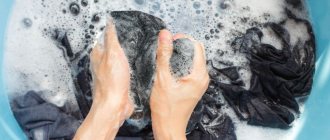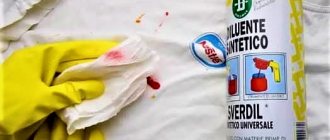Clothes cannot stay bright forever, even with modern detergents and laundry detergents. At a certain point, the product becomes faded. How to fix this?
After all, you can’t throw away a faded blouse or dress every time. There are many recommendations for restoring the original color.
General rules
New items usually have labels that indicate how to wash these clothes: at what temperature, whether washing and spinning are possible. By following these instructions, you can keep your products in their original form for a long time.
Before washing, items are divided by color. Contrasting products should not lie in place; one of them will spoil the color of the other.
Detergents need the correct dosage. Colored items are usually washed with products marked “color”.
Any clothes need to be rinsed thoroughly, especially colored and dark ones. Therefore, modern devices have a special mode.
But even with proper handling of wardrobe items, they gradually fade. This happens due to:
- frequent washing and rubbing of the material;
- influence of the sun's rays;
- long-term storage in a closet
How to restore the color of a faded colored item from several colors
How to restore the color of a faded colored item from several colors
To remove stains on black items with white stripes or patterns, you will need salt and green tea. To prepare, brew 2 liters of tea, not very strong, filter and soak the laundry for 15 minutes. Then take out the product, squeeze it a little, apply salt to the white areas, leaving for the same time. Wash, rinse.
Color restoration products
If things have been washed many times and not entirely successfully, you can give them their former shine and color using:
- tobacco;
- ammonia;
- unripe nut shells;
- onion peel;
- black brewed tea;
- food vinegar;
- soda;
- coarse table salt;
- delicate bleaches
With these components you can get high-quality results. Let's tell you more about each of them.
Ammonia
This is a reliable substance for giving things a presentable appearance. As a rule, 1 liter. dissolve 20 ml of water. ingredient. Discolored cotton or wool items are placed in such a solution at room temperature and kept for 15 minutes.
If it is necessary to return the product to its original whiteness, add a little bleach to the water. To achieve crystal purity, the item of clothing is boiled in this solution for 30-40 minutes. But this is only possible if the label does not contain instructions prohibiting high temperatures.
Tobacco
Restores dark shades. 20 grams of the substance are diluted in 1 liter. water and leave for 30 minutes. After this, use a towel or brush to distribute the solution over the bleached fabric.
Onion peel
This ancient folk method is suitable for brown and green clothes. The onion peels should be cooked for a long time in boiling water. This is done to obtain a strong solution that gives the fabrics a brownish-golden or greenish tint. But before using such a product, you need to conduct a test - apply a little solution to the underside of the material. Different concentrations of the substance give different colors.
Starch
Suitable for returning color after washing clothes with mismatched items. Apply a starch mixture, which includes citric acid, table salt and soap shavings in equal quantities, to the detected stains and leave until the morning. After this, the items are washed and rinsed in warm water.
1: Use gray cards
These things work wonders when shooting in controlled environments where you can influence the amount of lighting or at least the subject. Taking an initial photo with a gray card in the frame provides an area that will serve as a reference area of 18% gray. If you are not familiar with this concept, this paragraph may not seem entirely clear to you. Just know that we are trying to set a benchmark that can be used when working with white balance in Photoshop/Lightroom/ACR. You can also use larger gray cards/objects to calibrate your camera's white balance.
That's the problem. I often see articles about color grading ending after a discussion of white balance. To be honest, by setting the correct white balance, you will not get an absolutely “correct” photo. If there are mixed light sources in the frame (for example, fluorescent lamps or tungsten filament lamps), some objects may take on a completely different shade of color. Trying to fix all this is quite difficult! However, gray cards are always a good first step towards achieving the desired result.
- The gray 12" x 12" card can be purchased on Amazon.
Delicate chemical bleaches
Typically used for washing clothes. Before using them, you need to read the instructions. Otherwise, the products may be damaged.
The most popular soft bleaches:
- Perox. Used for all types of material. It consists of surfactants and bleaching agents that not only remove stains, but also add brightness to things.
- "Vanish" Safe because it does not contain chlorine. Can be used even at low temperatures. Suitable even for wool and silk.
2: Calibrate your monitor!
I can't even tell you how important this is. There are often several options available to set the calibration to a specific standard, be it the printer model, corporate requirements, or any other "realistic" color settings - it all depends on the calibration device. This means that your processed photos will appear as close as possible to how you want others to see them.
Being still young and inexperienced, I did a bunch of photo shoots with my friends as models. Then I processed the pictures - it was so cool. But when I saw the photos on my phone and another computer, their skin tone turned golden! And it was not just a faint glow, but a full-fledged golden shade. The background, which should have looked white or gray, also took on a yellow tint. I was so ashamed! Calibrating your monitor will help you avoid such failure.
In addition to the above, if you work on different devices, calibrating them is vital because you need to see the same color everywhere. Otherwise, you'll make a photo look good on one screen, then open it on another computer two days later and realize everything has turned purple. I sometimes transfer a photo between several computers, as well as between my wife’s phone and my own, to visually determine the appearance of the photo on different devices.
- The Datacolor Spyder5RPO is an excellent and relatively inexpensive calibration system.
Restoring Vibrant Colors
To return clothes to their original shades, there are many old methods used at home. For white items, washing and soaking with bleach is effective. Whiteness is also restored using a non-concentrated solution of potassium permanganate. Cleanliness and freshness can be achieved by washing with laundry soap.
Since ancient times, in order to brighten beige, terracotta and cream shades, things have been dipped in a weak tea solution. In the same way, nylon stockings and tights are refreshed - they become more richly colored.
If you wash items of delicate colors (pink, peach), add ammonia to the water. Products decorated with decorative threads are soaked in a warm salt solution. In order for its concentration to be optimal, you need to add 2 teaspoons of table salt for every liter of water. Then the clothes are washed in soap and water and rinsed well. The dried item is carefully ironed from the inside out.
Causes
The most common causes of dull clothing are:
- Violation of technology for caring for things. Manufacturers place all the information about the product on labels, which are attached either to the seams or on a separate tag. Items are marked with permission or prohibition for machine washing or ironing, as well as the maximum temperature and the use of chemical detergents.
- Aggressive detergent. Often special chemical compounds are added to powders, which not only remove dirt, but also help quickly wash out paint from fabric fibers.
- Frequent wear. When you constantly wear one or another element of your wardrobe, there is a need to wash it, which will lead to fading over time.
- Poor quality clothes. Even with proper care, the product will fade if it is made from low-quality raw materials
After purchasing a new wardrobe item, it must be washed by hand and separately from other items. This way, you can evaluate how much the product loses paint and not be afraid that it will affect the color of other things.
If the fabric does become dull, you can revive it yourself. After restoration, the product can be worn for a long time.
How to maintain the saturation of dark shades
Black and blue items are very comfortable for daily use. But from constant washing they fade and lose their former luster.
Tobacco or tea solution perfectly maintains the black color. You can freshen things up a little and restore color depth by rinsing in salt water. Also, hardware stores sell special products for washing and dyeing dark clothes. They can make the color uniform if some areas of the item are worn out.
Table vinegar and baking soda, which are added directly during washing, will help make red and blue things brighter. 1 medium spoon added per liter of water returns wardrobe items to their previous presentation.
Many housewives recommend diluting ammonia in warm water. Blue and cyan color is restored in such a solution in a matter of hours.
7: Use Curves to hide specific problem areas
This is where things get a little complicated. There is a great article on color theory by Nathan St. Andre at this link - read it if you want to get more in-depth knowledge! However, color theory is based on so-called "subtractive" colors. This means that when colors are mixed, the resulting shade becomes darker.
Light has an additive pattern. By adding another colored light to one, you get a color that is closer to white. The most basic and clear difference: three primary subtractive colors create black, and three primary additive colors create white. Moreover, in an additive color scheme, the three primary colors are the result of a combination of the three subtractive primary colors - red, yellow and blue. (Translator's note - there is most likely an error here, since the subtractive circuit contains magenta, not red.) The additive circuit consists of red, green and blue (an example of this is RGB monitors).
Each of the primary colors has its own complementary color, which is where the CMYK model comes from. C stands for Cyan, M stands for Magenta, Y stands for Yellow, and K stands for Key, but we won't need it now. RGB and CMY are arranged in this order because of their complementary pairs: red-cyan, green-magenta, blue-yellow. The more red there is in the photo, the less cyan, the more magenta, the less green, etc. This is the basics of color correction using curves.
Let's say you have a photo that appears too blue (like the one above) even after adjusting the levels. You simply add a Curves adjustment layer, select the Blue channel and drag the point down (you can also use the arrow on your keyboard for this). This reduces the amount of blue in the photo, allowing more yellow to appear. Then you can continue to adjust the photo, that is, if after this it has become too purple, you can switch to the Green channel and pull the curve a little higher, drowning out the purple with green. It is important that all this is not done destructively - you can always go back and correct a specific part.
I deliberately lowered the curve too much to demonstrate how the photo became more yellow. Notice that the image has also become darker.
Restoring the color of faded items
The latest laundry detergents can cope with almost any stain, but they are unlikely to be able to restore the original color of faded clothing.
Let's try to figure out why clothes fade from the sun's rays. The fact is that under their influence, coloring pigments are destroyed. It is impossible to give things the same appearance, but adding a little color or painting the material is quite possible. For this purpose, special chemical compounds can be used, for example, “Color Restorer” by Dr. Beckmann or “Color Magic”.
For those who do not trust store-bought drugs, you can use traditional methods. At home, faded things are painted:
- onion peel;
- tea leaves;
- tobacco solution
We looked at the simplest and most popular ways to restore the former brightness of color to faded clothes. If the product is expensive and it is unclear how the use of synthetic or natural products will affect it, it is better to contact a dry cleaner.
How do you like the article?
5: Two pairs of eyes are better than one
Making friends with other photographers is a very good practice, especially for those whose interests differ from yours. They will be able to provide some constructive criticism and offer advice that you would not have come up with on your own. Among other things, this also provides an extra pair of eyes that helps detect processing errors. After you look at a photograph for too long, sometimes even for days, your eyes become accustomed and instead of the real picture you begin to see what should be there. One of the best ways to get out of this state and “blur” your gaze is to take a short break, and during this time ask someone to look at the result and share their opinion.
I'm not an expert in color grading. My way of dealing with unwanted color casts is to do my best to take control of every ray of light. When I know what the light source is and what its temperature is, controlling the lighting becomes much easier. Unfortunately, this is not always possible. Projects, expectations and interests vary greatly and correlate differently with lighting conditions; I have a few friends that I turn to if I need help with processing.
Drink enough fluids
This is the first and key point. The skin is 64% The Role Water Plays in Skin Health water. Therefore, the amount of moisture in the body has a direct impact on the condition of the epidermis.
Stephen Deliduca
dermatologist
Without sufficient water intake, the epidermis becomes duller and wrinkles and pores become more visible. The right level of hydration helps the skin become firm and increases its elasticity. This means that it is less susceptible to the appearance of wrinkles, irritation and age spots.
To improve the condition of the skin, it is enough to drink the amount of liquid recommended by Dietary Reference Intakes: Water, Potassium, Sodium, Chloride, and Sulfate daily by physiologists:
- approximately 3.7 liters for men;
- about 2.7 liters for women.
This volume can be gained both from drinks (water, fruit drinks, tea, coffee, juices), and from soups or even solid foods - juicy fruits and vegetables.
Prefer green tea to black
Green tea has anti-inflammatory properties and soothes Green tea in dermatology – myths and facts the skin - reduces the amount of irritation, thereby evening out its color. Bonus: This drink contains antioxidants that slow down aging and wrinkles.
Drink iced 11 Steps to better skin tea. Hot drinks can cause redness of the skin.
Andrea Cambio
dermatologist
For the effects of green tea to be fully realized, you should drink at least a couple of cups a day.











